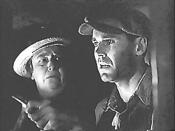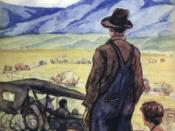The tone set forth in The Grapes of Wrath, was a quiet, sad tone from the start, based on Steinbeck's description in the very first sentence of the book "To the red country and part of the gray country of Oklahoma, the last rains came gently, and they did not cut the scarred earth..." Another tone portrayed early on was anger by sellers and businessmen, "Spend all their time looking. Don't want to buy no cars; take up your time. Don't give a damn about your time." Steinbeck achieved the poor, sad tone as one of his main objectives from the very beginning. He conquered it through his writing style. Every other chapter he set a tone, a mood, a sense of being, and what the time was like by taking the reader away from the Joad family, and painting a picture through a specific subject, but through random description.
Steinbeck often used short sentences, fragments as a matter-of-fact, but he used them craftily and well to where they made sense. He used this to cause a tone of desperation. "If he'll take twenty-five, I'll do it for twenty. No, me, I'm hungry. I'll work for fifteen. I'll work for food. The kids. You ought to see them..."
Steinbeck is a sure fan of figurative language, his books wouldn't be as great with out them. In The Grapes of Wrath there are several examples of such figurative language. Here are a few examples of such language:
(1) Steinbeck compares a willow tree "....its load of leaves tattered and scraggly as a molting chicken."
(2) He described a man driving a tractor as "....a robot in the seat."
(3) Then, later, "....I'll pot you like a rabbit."
(4) When speaking of the condition of Tom Joad's house he came...



Grapes of Wrath...
Flows smoothly...iinforms the reader and supports the title...
Overall a fair item for research and/or leisure reading...
Good Job...
3 out of 3 people found this comment useful.